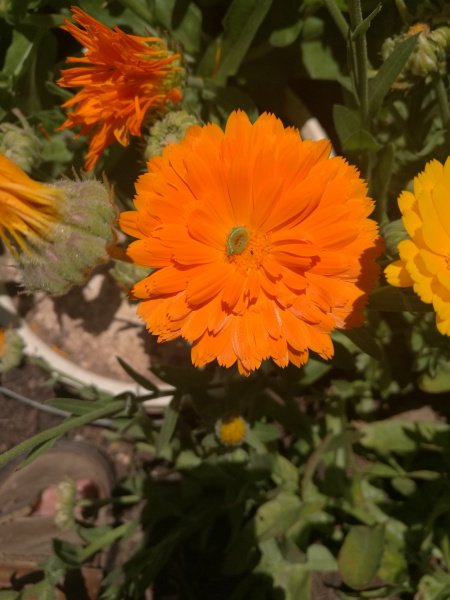Calendula (Calendula officinalis)

Common names: Calendula, Marigold, Pot Marigold
Taxonomic name: Calendula officinalis
Family: Asteraceae
Uses: Food, dye, anti-inflammatory, moves the lymphatics, liver cleanser
Area of origin: South Western Asia, Western Europe, Mediterranean
Warnings: None
Calendula (Calendula officinalis), is that bright, sunny splash of orange or yellow that could be brightening everyone’s garden about now at the end of winter. As with all the herbs we’ll be covering, Calendula is prolific, easy to find and just keeps on giving. The name ‘Calendula’ has the same roots as the word ‘calendar’ and refers to the fact that it is available all year round.
Calendula is probably most famous for its external use on wounds of all sorts, from cuts and scrapes to nasty lacerations. It can also be used internally for wounds from surgery to speed healing and reduce inflammation and infection. We used Calendula tincture in her water recently to help a friend’s dog after an operation.
Calendula works best on capillaries, strengthening them and increasing their flow. I think this is the key to most of their healing properties. Stronger capillaries, better flow, better drainage…you can see the picture.
Speaking of blood, Calendula has the ability to help regulate menstrual flow and timing. The physiology of this is quite complex, and not limited to one or two compounds. It is a dynamic interaction of forces. Flow is not increased further if it is already enough, nor decreased further if already too little. Rather, Calendula helps to normalise flow and timing.
So, Calendula is good for us inside and out. There are many other properties that you will see listed in many herbals, it’s such an amazing herb.
The bright yellow of the flowers indicates that Calendula is great for soothing inflammations, whether applied internally or externally. It is simple to make a cream, oil or tincture from the petals (though it is a plant best used dry, as the petals have a high moisture content). I like to wilt the petals away from the full sun for a couple of hours before using.
Calendula is a great one for the liver…it helps it to clean wastes by supporting the tissues that help do that job. It’s also known for its ability to help move the lymphatic fluid in the tissues, making it a doubly good healer.
The pattern we can see is one of the plants available in early Spring being good for the liver. They are cleansers and soothing remedies for inflammation. We can’t say that every herb available around at the moment fits this pattern, but the time of the year is a good clue as to which things a plant can heal.
When I use it, I look at its energetics of cooling and drying and it’s taste, which is bitter. I think of its ability to heal and strengthen capillaries throughout the body and that gives me a pretty good picture of whether it is suitable for the case in mind.